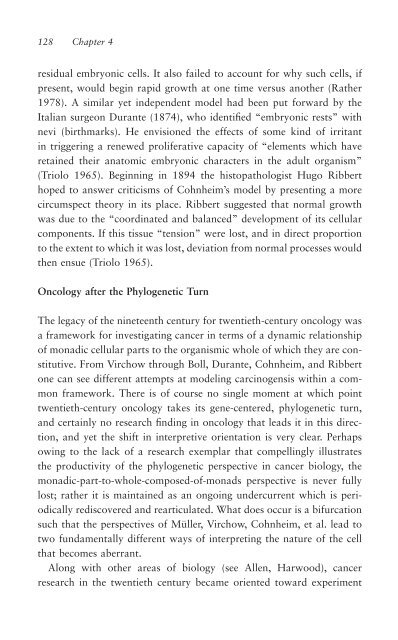A Critique of Pure (Genetic) Information
A Critique of Pure (Genetic) Information
A Critique of Pure (Genetic) Information
You also want an ePaper? Increase the reach of your titles
YUMPU automatically turns print PDFs into web optimized ePapers that Google loves.
128 Chapter 4<br />
residual embryonic cells. It also failed to account for why such cells, if<br />
present, would begin rapid growth at one time versus another (Rather<br />
1978). A similar yet independent model had been put forward by the<br />
Italian surgeon Durante (1874), who identified “embryonic rests” with<br />
nevi (birthmarks). He envisioned the effects <strong>of</strong> some kind <strong>of</strong> irritant<br />
in triggering a renewed proliferative capacity <strong>of</strong> “elements which have<br />
retained their anatomic embryonic characters in the adult organism”<br />
(Triolo 1965). Beginning in 1894 the histopathologist Hugo Ribbert<br />
hoped to answer criticisms <strong>of</strong> Cohnheim’s model by presenting a more<br />
circumspect theory in its place. Ribbert suggested that normal growth<br />
was due to the “coordinated and balanced” development <strong>of</strong> its cellular<br />
components. If this tissue “tension” were lost, and in direct proportion<br />
to the extent to which it was lost, deviation from normal processes would<br />
then ensue (Triolo 1965).<br />
Oncology after the Phylogenetic Turn<br />
The legacy <strong>of</strong> the nineteenth century for twentieth-century oncology was<br />
a framework for investigating cancer in terms <strong>of</strong> a dynamic relationship<br />
<strong>of</strong> monadic cellular parts to the organismic whole <strong>of</strong> which they are constitutive.<br />
From Virchow through Boll, Durante, Cohnheim, and Ribbert<br />
one can see different attempts at modeling carcinogensis within a common<br />
framework. There is <strong>of</strong> course no single moment at which point<br />
twentieth-century oncology takes its gene-centered, phylogenetic turn,<br />
and certainly no research finding in oncology that leads it in this direction,<br />
and yet the shift in interpretive orientation is very clear. Perhaps<br />
owing to the lack <strong>of</strong> a research exemplar that compellingly illustrates<br />
the productivity <strong>of</strong> the phylogenetic perspective in cancer biology, the<br />
monadic-part-to-whole-composed-<strong>of</strong>-monads perspective is never fully<br />
lost; rather it is maintained as an ongoing undercurrent which is periodically<br />
rediscovered and rearticulated. What does occur is a bifurcation<br />
such that the perspectives <strong>of</strong> Müller, Virchow, Cohnheim, et al. lead to<br />
two fundamentally different ways <strong>of</strong> interpreting the nature <strong>of</strong> the cell<br />
that becomes aberrant.<br />
Along with other areas <strong>of</strong> biology (see Allen, Harwood), cancer<br />
research in the twentieth century became oriented toward experiment
















